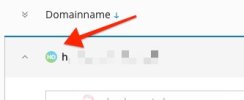- Server operating system version
- CentOS Linux 7.9.2009 (Core)
- Plesk version and microupdate number
- Plesk Obsidian Version 18.0.49 Update #2
Hello!
Can I disable the generated favicons (see example) displayed since a recent update through the panel.ini?

Many sites have favicons that are generated from Worpdress and therefore there is no physical ico file on the web. The view in Plesk is therefore confusing and annoying.
I have tried to solve this awkwardly via a CSS plugin in the browser, but I think there should be a basic change for this kind of presentation. Especially since dynamic favicons are rather state of the art...
Thanks for any advice!
Can I disable the generated favicons (see example) displayed since a recent update through the panel.ini?

Many sites have favicons that are generated from Worpdress and therefore there is no physical ico file on the web. The view in Plesk is therefore confusing and annoying.
I have tried to solve this awkwardly via a CSS plugin in the browser, but I think there should be a basic change for this kind of presentation. Especially since dynamic favicons are rather state of the art...
Thanks for any advice!
